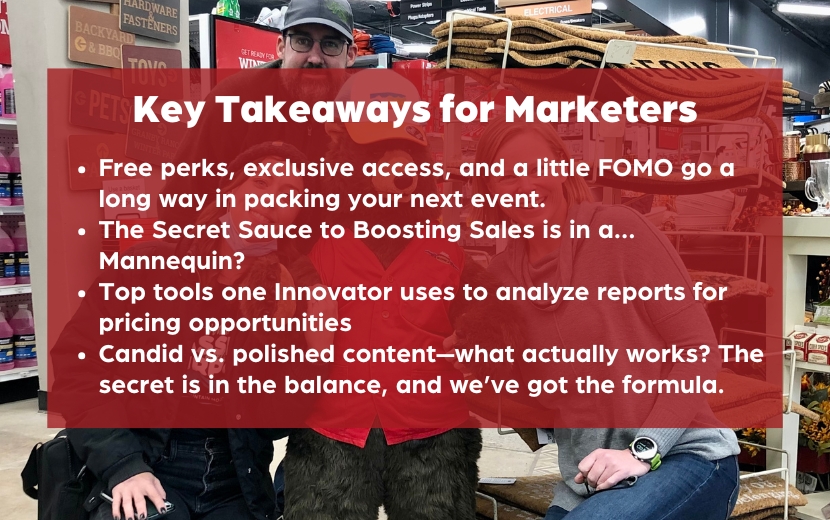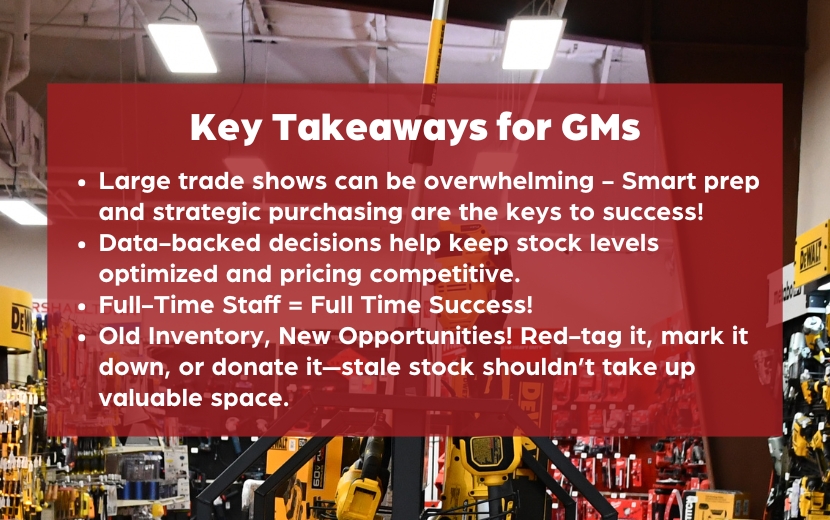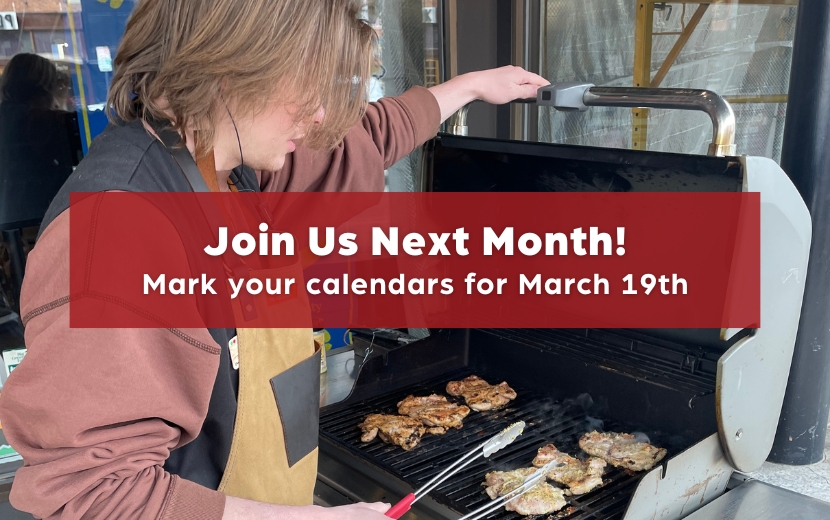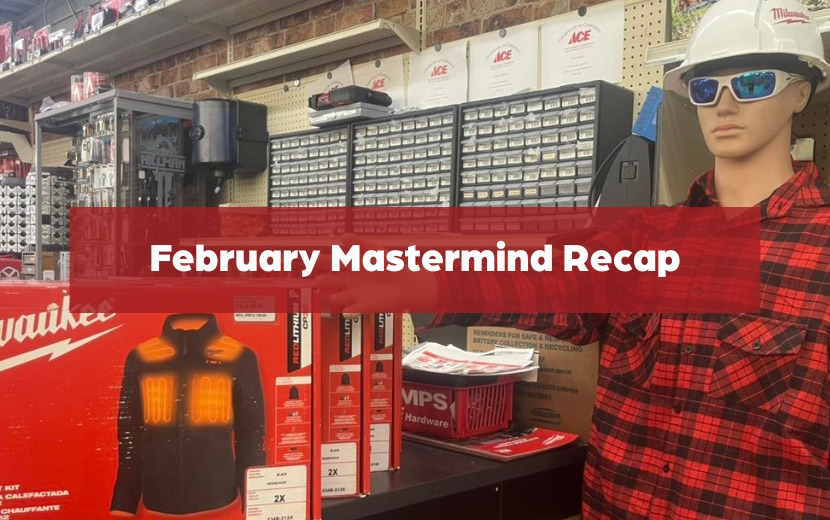This month’s Hardware Innovators Mastermind was a wealth share of knowledge. Our Marketing folks talked through sales opportunities outside of Red Hot Buys, and the General Managers spoke about inventory ordering, discounting, and discontinuing tips. Let’s dive in!
Marketing Mastermind Takeaways:

Takeaway #1: Sales & Product Pricing
We discussed innovative ways to optimize pricing, move inventory, and engage customers. Here are some of our top talking points:
- TAKE THE TIME to Analyze Reports for Pricing Opportunities: One owner/marketer is utilizing tools found in the RAD (Retail Analytics Dashboard) and MANGO, to sit down with his inventory person (or group of people at times) to make a list for product competitiveness and adjust his prices. PS- he pointed out that there is a whole team at corporate waiting for calls about inventory pricing and to talk through optimizations, you just have to pick up the phone.
- Leverage Dynamic Pricing: Adjust prices on competitive products while raising margins on non-competitive items—this strategy, obvious because of the industry we’re all in, but sometimes pushed to the back burner, could increase revenue by $25,000 annually for only a few hours of your time.
- Implement Red Tag Sales: When your team is labeling slow-moving inventory with progressively lower prices to create urgency and drive sales, it was discussed that you need to SHOW YOUR MARKETER those sales and have them post online!
- Showcase Deals on Social Media: Take photos of red-tagged or promotional items and for social and email newsletter content to attract in-store visits. Branding that you have sales goes against the mantra that we’re all about convenience, not pricing, but with the right messaging, good design, and consistent posts that the customer can expect to see 1-2 times a week, you can do both.
- Themed Promotions & Seasonal Sales: Run consistent targeted events like one group of stores does in Wisconsin (check out the 12 Days of Kimps-Mas) during slow times (once a quarter) with product discounts for different demographics.
- Engage Customers with Unique In-Store Marketing: One marketer brought up that if you don’t have one yet, your store needs a mascot! Whether it’s a stuffed animal with your store t-shirt on it, a dog, a mannequin, or one of your team members in a fun costume, GET A MASCOT. For instance, Rental Ron, a fun store mascot, highlights featured products in an entertaining way and is easy to dress up into timely themes. “Rental Ron can help get the word out about this month’s RHBs!”
- Stay Flexible & Adapt Marketing Plans: Regularly identify products that need to move, coordinate with department teams, and use eye-catching promotions to maximize visibility.
Takeaway #2: Tips on Gathering RSVPs for Events
One marketer asked about how to get people to ACTUALLY RSVP to an event, and the group members all sighed that they’d had similar issues, especially for builder-focused (and B2B) gatherings.
The consensus? RSVPs are crucial for planning but should come with incentives to encourage sign-ups. Here are some of the ideas our Innovators came up with:
- Offering free perks or adding a sense of urgency—such as limited spots—helps drive action.
- Guilt them and tell them you need names for food ordering purposes.
- Have a list at the event that would make those who did RSVP feel special and those who didn’t rsvp in the future.
There was a cool share about how 90% of RSVPs will show up and another 10% will show up without RSVP, so hopefully, your predicted numbers come true. (Thanks, Brandon, for this tip!)
Takeaway #3: Hosting Local Community Events
Our innovators talked about the impact of hosting local events to strengthen community connections and drive in-store traffic. Partnering with local attractions, such as dirt track raceways or fishing tournaments, creates valuable cross-promotion opportunities and expands audience reach.
- In-store events like Ladies Night – These generate excitement and increase foot traffic, especially when paired with free tickets and a waitlist to create a sense of exclusivity.
- If space is limited, utilizing parking lots for large-scale promotions can still bring the community together while showcasing products.
- Leverage social media and word-of-mouth marketing – Drives attendance, increases content engagement, and customer testimonials help spread awareness.
Ultimately, making events an experience—whether through grand openings, grilling events, or interactive product demonstrations—encourages customers to return and strengthens brand loyalty.
Takeaway #4: Candid Content vs. Polished Content
We discussed the difference between candid content, such as in-store moments, behind-the-scenes footage, and entertaining mascots like Rental Ron and how that tends to perform WAY better on social media than the polished stuff. Stay authentic and true to your personality; don’t overdo it or get too “Walmarty”.
Meanwhile, polished content does have a place, like professionally designed posts, and brand-focused visuals do provide a more refined and cohesive look when appropriate. Striking the right balance is key—One of our Innovators is testing a 2:1 ratio, favoring polished content while incorporating two candid posts per week to maintain engagement. Employee spotlights are another effective way to blend authenticity with professionalism. To stay organized, using a content calendar helps plan and structure posts, ensuring consistency and a mix of engaging content styles.
Helpful Resources for Marketers
General Managers Mastermind Takeaways:

Takeaway #1: Mango Reports
One innovator spoke about Mango Reports’ role in identifying which products to discontinue and which to restock. While the data provides valuable insights, it’s still important to ask the right questions—just because a product hasn’t been ordered since 2022 doesn’t automatically mean it should be discontinued. Context matters; if it’s a common item like a broom among several other options, it may not be necessary to restock, but for specialized products like plumbing fittings, reordering could be essential. Tracking these patterns helps prevent unnecessary inventory buildup while ensuring key products remain available.
Pricing also remains a key consideration, as customers who are price-conscious will compare costs with big-box retailers. Using Mango Reports strategically allows for better inventory decisions, keeping pricing competitive while optimizing stock levels.
Takeaway #2: What to Do With Old Merchandise
We discussed how to deal with old or discontinued merchandise. The first step is to red tag it, gradually lowering the price to move it quickly. If items still don’t sell, donating to organizations like Habitat for Humanity is a great way to clear space while supporting the community.
When bringing in new products, it’s essential to have a plan for the old inventory, whether through markdowns, targeted sales, or reaching out to local businesses, like apartment complexes, that may need bulk items (like lightbulbs). Proactively managing old stock ensures smoother transitions for new merchandise and minimizes excess inventory.
Takeaway #3: Benefits of Full-Time Employees
Many businesses are shifting to full-time employees for better consistency, product knowledge, and engagement. While part-time staff can be helpful, full-time employees tend to provide stronger expertise, especially in specialized areas like plumbing. One Innovator is experimenting with requiring one night shift a week and alternating weekends, which would conflict with the schedules and preferences of part-time team members.
Prioritizing full-time staff reduces turnover, improves service, and strengthens team reliability.
Takeaway #4: Crafting the Perfect Plan for Large Conventions
Attending large conventions like the Ace Convention requires a well-crafted strategy to maximize time and investment. With the sheer size of these events, one Innovator discussed that you can typically only get through a third of the show on the first day, making pre-show homework essential.
Knowing what inventory you already have, what still needs to move, and what space is available for new products ensures smarter decision-making. A key approach is to hold off on placing orders on the first day, allowing time to explore, compare options, and make informed purchasing decisions. Since managing inventory is an ongoing challenge, careful planning helps prevent overstocking while still taking advantage of valuable opportunities at the show!
Helpful Resources for GM’s
- Radical Candor – Kim Scott
- 2025 NHPA Market Measure Report
- GGOB: Gives you a formula to do profit share on a quarterly basis. This is based on actual performance vs forecasted goals. Allocate a certain percentage for the bonus based on how profitable the company is.
- Two great Webcam & Microphone options for computers that don’t come with them:
- Logitech C920x Pro HD Webcam
- NexiGo N930AF 1080p Webcam
- Both options are budget-friendly and should meet your needs for reliable video and audio during Zoom calls on both Windows and Mac platforms.

Join us on March 19th for Our Next Mastermind
For March, we’ll have two groups that meet: Marketing and GMs.
Marketers will talk about mobile app downloads and how to leverage it.
GMs will discuss the who, what, when, where, and how of community-wide, in-store, and contractor events. You won’t want to miss this!
Need help signing up? Send us an email: hello@hardwareinnovators.com
Are You On Board?
Does the idea of a monthly meet-up with other retail hardware stores sound valuable? Would you like to share resources, ask questions, and participate with your peers on-demand through an exclusive Slack channel?
Email us at hello@hardwareinnovators.com to get access to the Slack Channel! The best part? It’s 100% free and puts you in touch with hardware store general managers and marketers to ask questions and get immediate feedback from what worked at other hardware stores!

